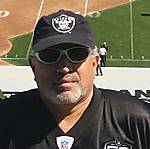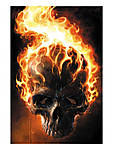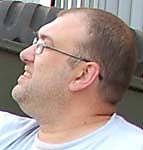Panther Dudes,
I miss another item, so If you’ll take a close look at the first photograph on my last posting above you’ll notice that I placed a weld seam around the bottom of the antenna base made from a piece of .010” diameter styrene rod and softened with Tamiya’s liquid cement. On the real vehicle the antenna base was welded in place, Dragon missed this but I can’t complain, as this is one of their best-engineered kits that I have built from them to date.
Quoted Text
Thank you Eddie, it doesn't get any better then your running tutorial, nice feature you got going.
– Anthony, although your build is complete it’s great to have you stop by and have a look-see of the ongoing builds, including mine. Thanks for the kudos I really do appreciate it!
Quoted Text
Here are some pictures of a Panther G I built 27 years ago . . .
– Pete, the internet was no where near where it is today and modeling websites like Armorama didn’t even exist when you created these models. Your rendering of the Panther G is awesome and well detailed, right down to the flame cut armor sides on the turret. Those photographs, although slightly aged, are also up to today’s posting standard. Thanks for sharing.
Quoted Text
My brief experience with PE has not been stellar. Marked poorly, parts within parts and so forth.
– Jeff, no choice! PE parts are here to stay and we should embrace the challenge and learn the ways of the PE. Nice progress on the 76th scale Jagdpanther.
Quoted Text
Right now I'm working on the Dragon IR sights that Mike kindly donated me, those clear parts are very detailed but I already misplaced a tiny detail .. it jumped the tweezers, I couldn't find a 2mm clear part 
– John, you may not be aware of this yet but I believe that both the tweezers and carpet have a thing going on! You’re making good progress on your build. I think you’re using one of the largest PE sets in this campaign? Looking forward to seeing how the PE Zimmerit paste turns out once painted. Looks good so far.
Quoted Text
Eddy, You'll probably have a pretty good chance to catch up while I await the Arrival of my Panther's barrel and Bronco tracks.
– Rob, not a chance! Your figures look great. And what’s up with the small photographs, there not click-able? Are you and Jeff aka ‘imatanker’ putting the rest of us through some kind of eye test?
Quoted Text
@ Eddi I like that tinfoil method I may have to try that thanks for the step by step photos and description 
– Sal, glad you found something useful to add to your builds from my postings. Sharing is half the fun, nothing top secret!
@CMOT – Darren, the Zimmerit paste under the paint looks excellent as does the stripped paint scheme and tracks. About a comment I made earlier concerning your painted wheels I meant to write
‘now’ and I wrote
‘not’, oops!
@flyboy9994 – Randy, the camouflage you’ve rendered on both your builds look the part. I especially like the camouflage scheme on your Jagdpanther. And it looks like you’re busy with a few ongoing builds on the workbench too! You’re having fun!
@fireontheway – Timothy, I don’t know where your going with the lower half of your vehicle painted in red oxide primer and the upper half painted in camouflage?
@Panzerace – Burak, looking forward to seeing some progress on your Braille Jagdpanther.
@PantherF – Jeff, that resin flak turret looks really well detailed and is much larger in size than I had imagined it to be. It’s going to look terrific on the chassis.
@tylausfaust – Raul, an Arab nations Panther G? That would be interesting and thought provoking as well. Hope you have some help in finding out more about these vehicle, some photographs of the real vehicles would be nice, you could try posting a question concerning these vehicles in the WWII – Axis forum?
@TMoon – Tom, that large 1/16th scale Jagdpanther is going to look mighty impressive on the workbench. Maybe you could set a 72nd scale figure standing next to one of the wheels for scale comparison? That would look like something out of Star Wars!
@atoplu – Ayhan, good job on the build. I like the camouflage scheme on the turret. As a matter of fact I like it so much, you’ve given me an idea, and I’m going to be using a similar variation of your camouflage pattern on my Panther F. But I’m only going to be using only two of the colors, green and yellow or perhaps gray? The missing fender and anti-air guard over the air exhaust on the engine deck gives it a used for a while look. If I may, your track run over the top of the wheels is floating a little too much. You could see about securing them down against the tracks with a little superglue? I also like your personal logo, nice touch!
@Snori23 – Trevor, that large gun conversion for your Panther build sounds most interesting! Can I play too? Let’s go out with that Panther once its built and put some really big holes in the neighbor’s fence.
Quoted Text
I had the most trouble finding how and where to glue the jack rack, the instruction are very confusing regarding the emplacement of the PE rack.
– Phil, nice progress on your Flak Panther Ausf.D. I hope that the photographs below will be of some help to you. From your photographs it looks like you’ve placed the support brackets to the jack in the correct area. There where several ways to mount the jack and I think that it because of the numerous manufactures involved in the building of this vehicle?


 @BBD468
@BBD468 – Gary, good to have you drop by and check out the builds, hoping this will give you some incentive to join in on the fun? Campaign won’t end until December of this year, I am sure that an ongoing build from you posted here would be of much inspiration to everyone involved, think about it?
~ Eddy



























































